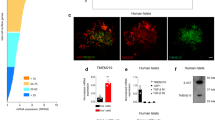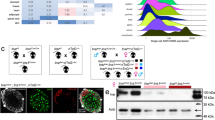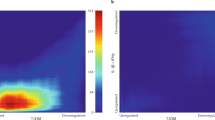Abstract
An appropriate β cell mass is pivotal for the maintenance of glucose homeostasis1. Both insulin and IGF-1 are important in regulation of β cell growth and function (reviewed in ref. 2). To define the roles of these hormones directly, we created a mouse model lacking functional receptors for both insulin and IGF-1 only in β cells (βDKO), as the hormones have overlapping mechanisms of action and activate common downstream proteins. Notably, βDKO mice were born with a normal complement of islet cells, but 3 weeks after birth, they developed diabetes, in contrast to mild phenotypes observed in single mutants3,4. Normoglycemic 2-week-old βDKO mice manifest reduced β cell mass, reduced expression of phosphorylated Akt and the transcription factor MafA, increased apoptosis in islets and severely compromised β cell function. Analyses of compound knockouts showed a dominant role for insulin signaling in regulating β cell mass. Together, these data provide compelling genetic evidence that insulin and IGF-I–dependent pathways are not critical for development of β cells but that a loss of action of these hormones in β cells leads to diabetes. We propose that therapeutic improvement of insulin and IGF-I signaling in β cells might protect against type 2 diabetes.
This is a preview of subscription content, access via your institution
Access options
Subscribe to this journal
Receive 12 print issues and online access
$209.00 per year
only $17.42 per issue
Buy this article
- Purchase on Springer Link
- Instant access to full article PDF
Prices may be subject to local taxes which are calculated during checkout




Similar content being viewed by others
References
Accili, D. Lilly lecture 2003: the struggle for mastery in insulin action: from triumvirate to republic. Diabetes 53, 1633–1642 (2004).
Kulkarni, R.N. New insights into the roles of insulin/IGF-I in the development and maintenance of beta-cell mass. Rev. Endocr. Metab. Disord. 6, 199–210 (2005).
Kulkarni, R.N. et al. Tissue-specific knockout of the insulin receptor in pancreatic β cells creates an insulin secretory defect similar to that in Type 2 diabetes. Cell 96, 329–339 (1999).
Kulkarni, R.N. et al. beta-cell-specific deletion of the Igf1 receptor leads to hyperinsulinemia and glucose intolerance but does not alter beta-cell mass. Nat. Genet. 31, 111–115 (2002).
Otani, K. et al. Reduced beta-cell mass and altered glucose sensing impair insulin-secretory function in betaIRKO mice. Am. J. Physiol. Endocrinol. Metab. 286, E41–E49 (2004).
Xuan, S. et al. Defective insulin secretion in pancreatic beta cells lacking type 1 IGF receptor. J. Clin. Invest. 110, 1011–1019 (2002).
Nakae, J., Kido, Y. & Accili, D. Distinct and overlapping functions of insulin and IGF-1 receptors. Endocr. Rev 22, 818–835 (2001).
Cho, H. et al. Insulin resistance and a diabetes mellitus-like syndrome in mice lacking the protein kinase Akt2 (PKB beta). Science 292, 1728–1731 (2001).
Alessi, D.R. et al. Characterization of a 3-phosphoinositide-dependent protein kinase which phosphorylates and activates protein kinase Bα. Curr. Biol. 7, 261–269 (1997).
Withers, D.J. et al. Disruption of IRS-2 causes type 2 diabetes in mice. Nature 391, 900–904 (1998).
Miura, A. et al. Hepatocyte nuclear factor-4alpha is essential for glucose-stimulated insulin secretion by pancreatic beta-cells. J. Biol. Chem. 281, 5246–5257 (2005).
Lee, J.Y. et al. RIP-Cre revisited: evidence for impairments of pancreatic beta-cell function. J. Biol. Chem. 281, 2649–2653 (2005).
Kennedy, R.T., Kauri, L.M., Dahlgren, G.M. & Jung, S.K. Metabolic Oscillations in beta-Cells. Diabetes 51 (Suppl.), S152–S161 (2002).
Kido, Y. et al. Effects of mutations in the insulin-like growth factor signaling system on embryonic pancreas development and beta-cell compensation to insulin resistance. J. Biol. Chem. 277, 36740–36747 (2002).
Mathis, D., Vence, L. & Benoist, C. Beta-cell death during progression to diabetes. Nature 414, 792–798 (2001).
Danial, N.N. & Korsmeyer, S.J. Cell death. Critical control points. Cell 116, 205–219 (2004).
Louvi, A., Accili, D. & Efstratiadis, A. Growth-promoting interaction of IGF-II with the insulin receptor during mouse embryonic development. Dev. Biol. 189, 33–48 (1997).
Olbrot, M. et al. Identification of beta-cell-specific insulin gene transcription factor RIPE3b1 as mammalian MafA. Proc. Natl. Acad. Sci. USA 99, 6737–6742 (2002).
Zhang, C. et al. MafA is a key regulator of glucose-stimulated insulin secretion. Mol. Cell Biol. 25, 4969–4976 (2005).
Kitamura, Y.I. et al. FoxO1 protects against pancreatic beta cell failure through NeuroD and MafA induction. Cell Metab. 2, 153–163 (2005).
Da Silva Xavier, G., Qian, Q., Cullen, P.J. & Rutter, G.A. Distinct roles for insulin and insulin-like growth factor-1 receptors in pancreatic beta-cell glucose sensing revealed by RNA silencing. Biochem. J. 377, 149–158 (2004).
Goforth, P.B. et al. Calcium-activated K+ channels of mouse beta-cells are controlled by both store and cytoplasmic Ca2+: experimental and theoretical studies. J. Gen. Physiol. 120, 307–322 (2002).
Zhang, M., Houamed, K., Kupershmidt, S., Roden, D. & Satin, L.S. Pharmacological properties and functional role of Kslow current in mouse pancreatic beta-cells: SK channels contribute to Kslow tail current and modulate insulin secretion. J. Gen. Physiol. 126, 353–363 (2005).
Hashimoto, N. et al. Ablation of PDK1 in pancreatic β cells induces diabetes as a result of loss of β cell mass. Nat. Genet. advance online publication 23 April 2006 (doi:10.1038/ng1774).
Wolfer, D.P., Crusio, W.E. & Lipp, H.P. Knockout mice: simple solutions to the problems of genetic background and flanking genes. Trends Neurosci. 25, 336–340 (2002).
Fisher, S.J. & Kahn, C.R. Insulin signaling is required for insulin's direct and indirect action on hepatic glucose production. J. Clin. Invest. 111, 463–468 (2003).
Kulkarni, R.N. et al. Impact of genetic background on development of hyperinsulinemia and diabetes in insulin receptor/insulin receptor substrate-1 double heterozygous mice. Diabetes 52, 1528–1534 (2003).
Kokkotou, E.G., Tritos, N.A., Mastaitis, J.W., Slieker, L. & Maratos-Flier, E. Melanin-concentrating hormone receptor is a target of leptin action in the mouse brain. Endocrinology 142, 680–686 (2001).
Kulkarni, R.N. et al. Altered function of insulin receptor substrate-1-deficient mouse islets and cultured beta-cell lines. J. Clin. Invest. 104, R69–R75 (1999).
Aspinwall, C.A. et al. Role of insulin receptor substrate-1, phosphatidylinositol 3-kinase, and release of intracellular ca2+stores in insulin-stimulated insulin secretion in beta-cell. J. Biol. Chem. 275, 22331–22338 (2000).
Acknowledgements
The authors thank K. Frayjo for secretarial assistance, K.C. Hayes for housing and care of mouse colonies (Brandeis University), E. Krutoholow for assistance with mouse genotyping and S. Lannon for clamp experiments. We thank M. Magnuson (Vanderbilt University) for RIP-Cre mice on original mixed background; D. Melton (Harvard University) for PDX-Cre mice; and U. Jhala (University of California, San Diego) and T. Maratos-Flier, J. Elmquist and E. Kokkotou (Beth Israel Deaconess Medical Center) for discussions. This study was supported by US National Institutes of Health grants R01 DK067536, R01 DK066207 (to R.N.K.), R01 DK046409 (to L.S.), R01 DK046960 (R.T.K.) and P01 DK042502 (R.S.) and by the Joslin Diabetes & Endocrinology Research Center Specialized Assay and Advanced Microscopy Cores. I.A. is supported by Juvenile Diabetes Research Foundation Fellowship Grant 3-2003-579.
Author information
Authors and Affiliations
Corresponding author
Ethics declarations
Competing interests
The authors declare no competing financial interests.
Rights and permissions
About this article
Cite this article
Ueki, K., Okada, T., Hu, J. et al. Total insulin and IGF-I resistance in pancreatic β cells causes overt diabetes. Nat Genet 38, 583–588 (2006). https://doi.org/10.1038/ng1787
Received:
Accepted:
Published:
Issue Date:
DOI: https://doi.org/10.1038/ng1787
This article is cited by
-
New insights into β-cell failure, regeneration and replacement
Nature Reviews Endocrinology (2022)
-
Targeting pancreatic β cells for diabetes treatment
Nature Metabolism (2022)
-
Mice with gene alterations in the GH and IGF family
Pituitary (2022)
-
Insulin resistance and exaggerated insulin sensitivity triggered by single-gene mutations in the insulin signaling pathway
Diabetology International (2021)
-
Inceptor counteracts insulin signalling in β-cells to control glycaemia
Nature (2021)



